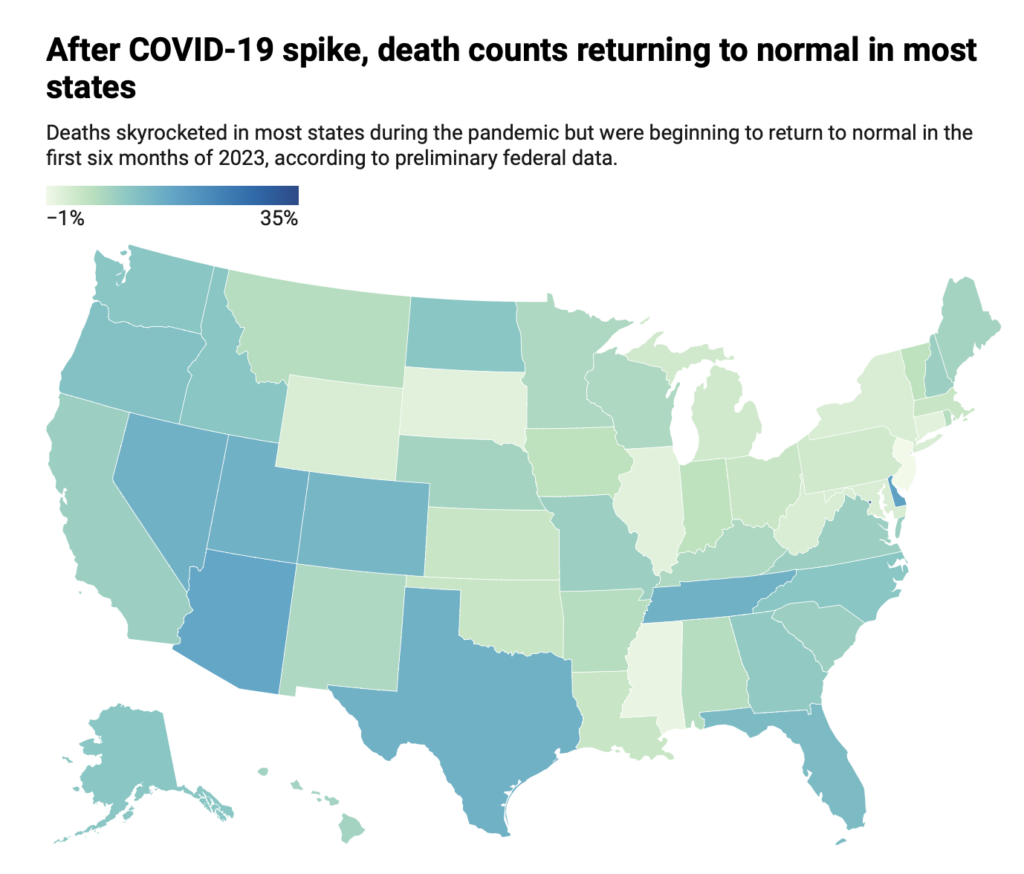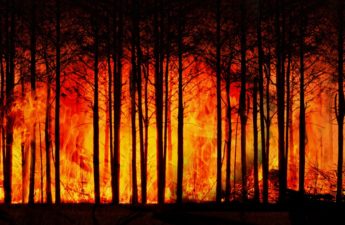
by Tim Henderson, Stateline
August 23, 2023
Several months after President Joe Biden ended the national emergency for COVID-19, preliminary health data indicates the historic degree to which the pandemic increased death rates nationwide — not just because of the virus itself, but also through the pandemic’s reverberating effects on society.
Deaths from vehicle crashes, homicides, suicides and overdoses spiked in many states during the national health emergency that began in January 2020. Deaths of despair, which include people who died by suicide or from an accidental overdose, reached their highest numbers during the first year of the pandemic. And even as fewer cars were on the roads during shutdowns, vehicle fatalities jumped.
Yet after historic increases during the pandemic, deaths in most of the country are nearing a return to pre-pandemic levels, according to a Stateline analysis of preliminary federal statistics.
Still, in the first half of this year, the death count in some states and the District of Columbia was much higher than it was during the first half of 2019. The District’s death count was 35% higher than before the pandemic, and in six states the count was at least 15% higher: Arizona, Delaware, Nevada, Tennessee, Texas and Utah.
Nationally, death counts for the first six months of 2023 are about 7.7% higher than they were for the same period in 2019, before the pandemic, the analysis found. That’s just a bit above the 6.7% increase to be expected anyway; counts routinely inch up annually with the United States’ aging population.
Before the pandemic, the historical trend since 1900 was for the number of deaths to rise a little every year as the population got larger and older, and for age-adjusted death rates to go down and life expectancy to rise every year due to advances in health and medicine.
COVID-19 played havoc with that pattern, bringing historic spikes in both death counts and death rates. Between 2019 and 2020, the number of U.S. deaths from all causes jumped 19%, a 100-year record. The current U.S. death toll from the virus is more than 1.1 million people, according to the World Health Organization.
The year-over-year spike in death rates between 2019 and 2020 surpassed that of the 1918 flu epidemic. In 2020, the death rate rose 17% to 835.4 per 100,000 people, compared with a 12% jump between 1917 and 1918. The death rate peaked at 879.7 in 2022.
Life expectancy in the United States dropped 2.7 years by 2021, the biggest dip in almost 100 years.
States where COVID-19 hit first, such as New Jersey and New York, are the closest to complete recovery.
Public health experts debate why deaths might be stubbornly high in some areas of the country — as in Arizona, where death rates rose the most between 2019 and 2022, and where increases in deaths continue to be high in preliminary 2023 data.
There’s some evidence that COVID-19 deaths have gone unrecognized, and that the chaos from the pandemic caused still more deaths by shutting sick people out of hospitals packed with COVID-19 patients.
“There’s a lot of things going on that might cause [continued high death rates]. It’s not just one thing,” said Robert Anderson, chief of the mortality statistics branch at the federal National Center for Health Statistics in Maryland.
Nationally, only about 62% of the increase in death rates between 2019 and 2022 is directly attributed to COVID-19, according to the Stateline analysis. But that might be an undercount because COVID-19 was not always detected as a cause, according to Boston University School of Public Health research published in January.
In the pandemic, unexplained or “excess deaths” tended to peak earlier than COVID-19 deaths did, suggesting that many deaths really were undetected COVID-19 deaths.
COVID-19 cases were more likely to be misclassified in Arizona, the Rocky Mountain states, the South and rural areas, than in New England and in mid-Atlantic states such as New Jersey and New York, the article said.
GET THE MORNING HEADLINES DELIVERED TO YOUR INBOX SUBSCRIBE
As deaths peaked in New Jersey in 2020, a report from the New Jersey Hospital Association said two trends suggested people were dying from lack of hospital care as well as COVID-19: an increase in deaths at home from conditions usually treated in hospitals, and a decrease in hospital admission for life-threatening emergencies like heart attacks and strokes.
New Jersey, despite being the first state hit hard by COVID-19 in 2020, is now the only state with fewer deaths in early 2023 compared with the first six months of2019. Eight other states saw increases of about 2% or less, including New York, another of the states slammed early in the pandemic.
The other seven states with death rates falling back to normal are Connecticut, Illinois, Maryland, Mississippi, South Dakota, West Virginia and Wyoming.
The year-over-year spike in death rates between 2019 and 2020 surpassed that of the 1918 flu epidemic.
COVID-19 is listed as a contributing cause of only 1,143 deaths in New Jersey so far this year, down from more than 14,000 in the same time frame in 2020. Similarly in New York, COVID-19 deaths were down to 2,685 from more than 32,000 early on.
New Jersey, like many other states, has worked hard to get the virus under control, reaching its goal to vaccinate 4.7 million people who live or work in the state by mid-2021, and zeroing in on hot spots as they popped up with concentrated publicity campaigns to boost testing and vaccination, said Nancy Kearney, a spokesperson for the state Department of Health, in a statement.
As an early epicenter of the virus, New Jersey became a laboratory for techniques that became standard practices in the rest of the country, said Cathy Bennett, president of the New Jersey Hospital Association.
“New Jersey health care providers were writing their own playbook for responding to this novel virus,” Bennett said. “Our hospital teams were among the first to use new medication and tactics like proning [turning patients face down] to ease the burden on COVID-19 patients’ lungs.”
But even Arizona is slowly returning to normal death patterns, despite spikes in February, April and May, according to an analysis by Allan Williams, an Arizona epidemiologist who collaborates on state reports. COVID-19 deaths in the state are down to fewer than a thousand so far this year, compared with about 7,000 at the peak during the same time period in 2021.
“Deaths are returning to normal,” Williams said.
The state faces unique challenges in that COVID-19 deaths spiked late compared with the East Coast, with peaks coming in late 2020 and early 2021 at much higher rates than nationally, according to Williams’ analysis.
Williams said Arizona also saw increases in deaths from a multitude of other factors, including traffic accidents, overdoses, firearms, heart disease and strokes.
The state-by-state difference in COVID-19 deaths has been studied and discussed by experts for years. COVID-19 had the biggest cumulative impact on Arizona from 2020 to mid-2022, according to a study published this March in The Lancet, which concluded some states did better than others in extending health care access equitably and in convincing residents to get vaccinated.
Hawaii, which took an early hit economically when tourism from Asia stopped even before the pandemic hit the United States, has been one of the least-affected states in terms of deaths.
A White House Council of Economic Advisers analysis last year calculated that if deaths in the whole country followed Hawaii’s pattern, another 780,000 people would have survived the pandemic. Hawaii and New England states got high marks for health care during the pandemic, though Hawaii is facing new challenges from COVID-19 as well as wildfire deaths on Maui.
The Council of Economic Advisers study also suggested that lower rates of health insurance were associated with more deaths. Health insurance rates have been rising and reached an all-time high last year, the latest figures available. Among those states with death counts that are at least 15% higher this year than they were during the first six months of 2019, Arizona, Texas and Nevada were also in the top 10 for uninsurance rates as of 2021, and Tennessee was 11th.
Changes in population could explain some of the differences among states. Many of the states with large death count increases also grew rapidly in 2022, and many of those with small increases are losing population.
But in some states, such as Arizona, the increase in deaths outpaced population gains. Between 2019 and 2021, the height of pandemic death rates nationally, Arizona’s age-adjusted death rate rose 38%, the biggest increase among states. Arizona also had the highest change in death totals between 2019 and 2022 at 21%.
Stateline is part of States Newsroom, a nonprofit news network supported by grants and a coalition of donors as a 501c(3) public charity. Stateline maintains editorial independence. Contact Editor Scott S. Greenberger for questions: info@stateline.org. Follow Stateline on Facebook and Twitter.


